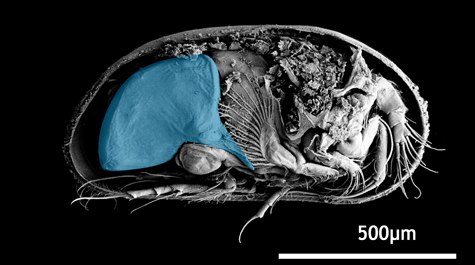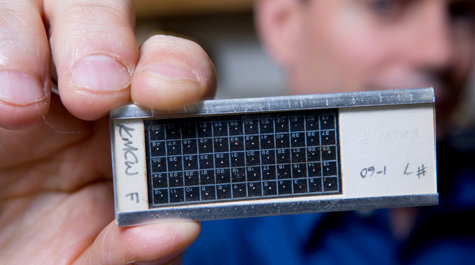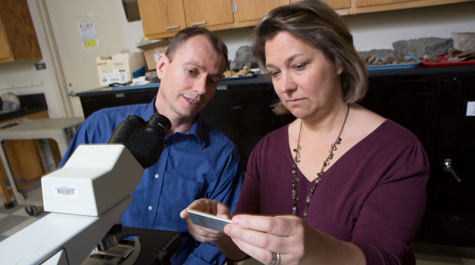In ‘Nature’: The tragedy of a bad sexual wager
There are significant advantages to developing massive male genitals — but there also can be a terrible cost.
It’s an evolutionary tale of caution revealed in an article published in the journal Nature. The co-authors, which include two William & Mary scientists, depict how overemphasis on masculine endowment began a path that led to extinction of entire species.
The paper is “High male sexual investment as a driver of extinction in fossil ostracods.” The William & Mary co-authors are Rowan Lockwood, professor of geology, and John Swaddle, professor of biology. Other authors are Maria João Fernandes Martins and Gene Hunt, both of the Smithsonian Institution, and T. Markham Puckett of the University of Southern Mississippi.
“The reason this is in Nature is because it is the first study linking sexual selection with actual extinction,” Swaddle said. “There have been papers that have linked sexual selection to indicators of extinction.”
Such “indicator” papers might focus on yeast colonies not being able to cope with a new environment or could be based on the International Union for Conservation of Nature list of threated bird species, he said.
The Nature study is an examination of the fossil record of numerous species of small crustaceans known as ostracods, or seed shrimp. It is a test of a theory about sexual selection, which is essentially a subset of natural selection, the Darwinian mechanism of evolution. The paper concludes that ostracod species that developed the largest male genitals went extinct at rates 10 times the species with the least investment in genital apparatus.
There’s more to life than procreation
Natural selection, writ small, holds that he or she who produces the most progeny wins. But Lockwood and Swaddle explain that organisms have business beyond procreation and therefore species that place too many evolutionary chips on reproduction may be making a bad long-term bet.
“Think of something like a peacock,” Lockwood said. “Male peacock trains are big, they’re showy, and we know that female peahens prefer males that have larger, more colorful and more symmetric trains. But those feather trains are also detrimental to the health and well-being of a peacock, because it makes them harder to take off and avoid predators.”
So sexual selection, she explained, pushes the peafowl population toward males with bigger, brighter, showier tails. The flashy plumage is an example of what the Nature paper calls “costly, exaggerated characteristics.” Such traits can operate at odds with other aspects of natural selection and might put wild peafowl populations on an eventual path to extinction, as a species’ evolutionary over-investment in traits linked to reproduction often comes at the expense of development of other systems.
“You have a situation where sexual selection is almost maladaptive for the species of peacock,” Lockwood explained. While peacocks work on increasingly showy and unwieldy tails, their predators may be evolving increasingly efficient peacock-hunting traits.
“It’s compromising their survival for the sake of getting mates,” Swaddle added.
Sexual selection takes many forms
Swaddle explained that sexual selection is generally thought of in terms of peacock-like competition to attract mates, but that’s not the only way sexual selection plays out. A peacock invests in huge plumage, while the male ostracod invests in huge genitals.
It’s only a slight exaggeration to say that a male ostracod is mostly penis, but an anatomical illustration reveals that the seed shrimp devotes more body-cavity real estate to its reproductive works than almost any other system. This apparatus is dominated by an organ that the authors of the Nature paper refer to as “the large, muscular sperm pump.” There are a number of facts to support Swaddle’s characterization of seed shrimp as “the Don Juans of the crustacean world.”
“Everything about an ostracod’s reproductive system is large. Some ostracods produce extremely large sperm,” Lockwood said. “If you were to take the sperm out of their sperm sack and line it up, it would be six times the length of the animal — a single sperm.”
Seed shrimp are internally fertilized. The male has two separate structures — called hemipenes, Lockwood said. The females have two openings that can accommodate a couple dozen eggs at once. And all of those eggs don’t necessarily have the same father.
“They don’t look like much, but sex is on the brain — what little brain they have,” Lockwood said.
Swaddle said that male ostracods face an evolutionary challenge known as “sperm competition.” If a female copulates with more than one male, the sperm compete with each other inside the female. He said a common evolutionary strategy to win the sperm competition is to simply produce higher numbers of sperm — “more tickets in the lottery.” Ostracods enter the sperm competition arena armed with bigger sperm — and a more powerful sperm factory.
Sperm competition: Yes, it’s a thing
“In this case — although we don’t really know this — the size of the sperm pump is probably an indication of how much competition is happening,” Swaddle said. “Because you can have competition among sperm from different males. It’s called ‘sperm competition.’ It happens in all kind of organisms — including humans.”
All of this happens in teeny little bivalve crustaceans. Ostracods are shaped like a sesame seed, but are even smaller. Lockwood says ostracods can live in fully marine, brackish\, and even freshwater environments.
“You can think of them as a kind of a shrimp in a shell,” Swaddle said.
“It’s hard to see that it’s a crustacean, but it’s a little like a shrimp,” Lockwood added. “These guys have heads, but they’re not as developed as shrimp heads are. They have a set of antennae. They have a set of legs. They use their legs for swimming, for walking around on the sea floor, for clinging to vegetation.”
Lockwood added that ostracods can withdraw into their shells: “They can be completely inside it for protection from predators. But most of their life, they spend with their shell gaped and the legs and antennae sticking out.”
Lockwood and Swaddle explain why ostracods make good study organisms for a study on sexual selection and its role in extinction. For one thing, there are a large numbers of seed shrimp species. There are a large numbers of ostracod species in the waters of the world today, but there are many, many extinct species as well. Plus, the extinct seed shrimp have not vanished — they are preserved in their once-swarming gajillions in the fossil record.
“We’re going back to the Cretaceous — 66 to 85 million years ago. This is the time of the dinosaurs, the time right before the dinosaurs go extinct,” Lockwood said. “We went back that far in part because ostracod species are long-lived in the fossil record. We wanted to make sure we had enough of a sample size of ostracods that had gone extinct.”
Sexing ostracods by shell differences
To top it off, ostracods — the quick and the fossilized — exhibit a high degree of sexual dimorphism. Males have a more elongated shell than the females in the same species. The longer shell is necessary to accommodate the oversize “copulatory apparatus,” as the paper says.
The strategy is to maximize the number of offspring, but what’s beneficial for the individual is not necessarily a good bet at the level of population or species. Swaddle explained that changes in the ostracod environment — temperature, salinity, etc. — put those high-stakes reproductive investments to the test.
“It’s not as if they’re sexing themselves to death,” he said. “At issue is the intense investment in sexual selection and mating strategies. It’s making them vulnerable to other things going on in their environment. It puts them at risk, and then when the environment changes in different ways, the species that are investing more heavily in reproduction are the ones more likely to go extinct.”
It just so happens that the oldest penis known to science belongs to a 425-million-year-old fossilized ostracod. Fossilized penises of any vintage are rare, as genitals are among what Swaddle calls the “soft parts,” of an animal and the fossil record usually preserves only “hard parts,” such as teeth, bones and shell.
About the precursor work…
Swaddle and Lockwood point out the Nature paper rests atop a large amount of precursor work. They credit Martins for her painstaking examination of the anatomy of modern ostracods, working as a post-doc with Hunt at the Smithsonian. Swaddle said her work on the understanding of those “soft parts” drew the connections relating sexual dimorphism in shell size/shape in seed shrimp of today and in the “hard parts,” as revealed in the fossil record.
“As a preamble to this, we published a series of studies to show that the kind of sexual dimorphism that we’re talking about here exists in modern ostracods,” he said. “And it exists because of investment in male reproductive organs.”
Some of the precursor also included contributions by William & Mary undergraduates. Swaddle has taught a sexual selection seminar at William & Mary for 17 years. (And Martins taught the seminar one year, as well.) One of the students, Luke Redding ’13, began his own investigation on the long-term costs of sexual selection.
“In that study, he set up little yeast colonies that were under different intensities of sexual selection and then testing whether they could cope with new environments,” Swaddle said. “Colonies with more sexual selection going on were less able to cope with change. It was a kind of a proxy for extinction risk.”
Redding worked with Swaddle and Helen Murphy, assistant professor of biology, and was a co-author on a paper on the yeast extinction-proxy study. Lockwood also had a research student involved in precursor work. Chrissy Hall ’12 interned for a summer at the Smithsonian as part of an ostracod collaboration with Lockwood and Gene Hunt.
“She’s gone on in paleontology and now is doing her Ph.D. on ostracods at the University of California, Riverside,” Lockwood said.
The interrelationships that began with the undergraduate research projects led the collaborators to formulate their own Nature-bound ostracod study and to apply for funding from the National Science Foundation.
They stress that their investigation into the extinction of tiny crustaceans millions of years ago has relevance for the many questions that arise in today’s world of rapidly changing environments. Lockwood points out that the paper offers a rare opportunity to use sexual dimorphism as a lens to examine extinction and extirpation at the level of entire populations and species.
“There are implications for conservation and restoration,” she said. “When species do put a lot of time and energy into reproduction, and the environment changes, they can become more vulnerable to extinction.”

















